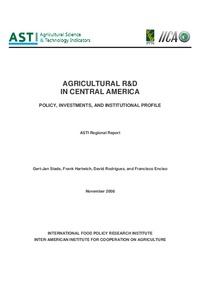Authors:
Stads, Gert-Jan; Hartwich, Frank; Rodríguez, David; Enciso, Francisco
Year:
2008
Publisher
International Food Policy Research Institute (IFPRI); and Inter-American Institute for Cooperation on Agriculture (IICA)
Back to:
Although the countries in Central America share many cultural and socioeconomic characteristics, important national differences of relevance to agricultural R&D exist among them. In countries like Guatemala and El Salvador, agricultural R&D is largely undertaken by government agencies, whereas most of the research in Honduras, Nicaragua, and Costa Rica is conducted by higher education agencies. In addition, the nongovernmental sector—which includes producer organizations plays a significant role in carrying out agricultural R&D in Honduras and Costa Rica.
In terms of capacity, Belize—the region’s smallest country—employed just 17 fte scientists in agricultural R&D in 2006 compared with 283 fte’s in Costa Rica. Central America as a whole spent $92 million (in 2005 constant prices) on agricultural R&D in 2006, equivalent to 0.31 percent of the region’s agricultural output. Although these totals would be somewhat higher if expenditures by regional agencies like CATIE were included, they are still very low compared with other parts of Latin America, other developing regions, and especially the developed world.
Costa Rica has the region’s most advanced agricultural R&D system and plays an important role in the development of new technologies, particularly for the emergent horticulture and food processing industries. In 2006, Costa Rica accounted for one-third of total Central American agricultural R&D spending, closely followed by Nicaragua. INTA—Nicaragua’s national agricultural research agency, which receives the vast majority of its budget from donors and multilateral development banks—accounted for nearly one-fifth of Central America’s agricultural R&D spending in 2006. Growth in agricultural R&D spending varied greatly across countries. During 1996–2006, Costa Rica experienced a 30 percent growth in its agricultural R&D investments, whereas spending in El Salvador and Guatemala
shrank by more than 40 percent.
Sources of agricultural R&D funding also differ widely across Central American countries. Research in El Salvador and Panama relies almost exclusively on funds provided by their national governments. Public agricultural R&D in Nicaragua, on the other hand, has traditionally been highly donor-dependent. Agencies in Costa Rica and Honduras show an increasing reliance on internally generated resources compared with other countries in the region, which can partly be explained by the
large nongovernmental sectors in these countries.
Linkages among the Central American countries have grown in the past decade, as have linkages with the United States—Central America’s largest trading partner. Although CAFTA, the free trade agreement, may have a negative effect on some of the region’s agricultural industries, it also offers broad economic opportunities to the region. To take advantage of these opportunities, the countries of Central America will have to overcome a range of challenges that affect its competitiveness. An often-voiced concern is that the region’s overall performance in agricultural innovation and capacity has been held back due to the fragmented nature of the region’s agricultural R&D systems and the lack of efficiency, for example, in term of duplication of effort. New innovation system and networking theory suggests that it is
not only the capacity of R&D agents and users that determine the level of innovation in the agricultural sector, but also the level of interaction, collaboration, and exchange of information and knowledge.
Greater economies of scope and scale could be achieved if the countries of Central America continue to integrate their agricultural R&D systems within each country, as a region, and in terms of the broader innovation system. Although some progress has already been made in this regard (for example, SICTA), integration should be extended to include nongovernmental institutions, producer organizations, the higher education sector, and the private for-profit sector. In addition to enhanced integration, a boost in agricultural R&D investments is called for—particularly in Guatemala and El Salvador—if Central America is to enhance smallholder production, cut (rural) poverty and to compete with top-quality agricultural products in a global market.

